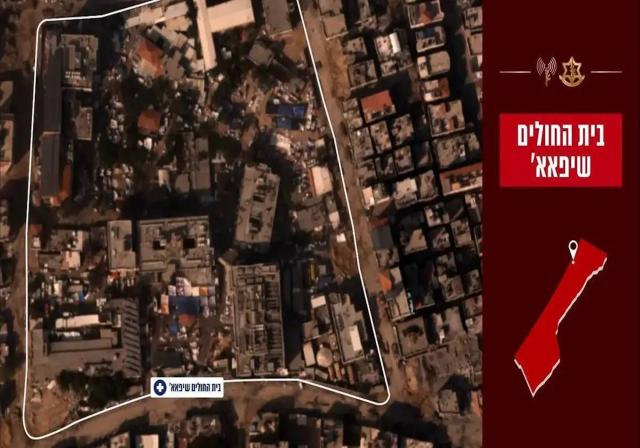In a significant escalation of conflict around Gaza’s largest medical facility, Israeli forces and Palestinian fighters engaged in intense combat in the vicinity of Al Shifa Hospital. This strategic site became an epicenter of conflict when Hamas and Islamic Jihad militants launched attacks against Israeli soldiers and armor, employing a combination of rocket and mortar fire. The Israeli military, asserting control over the area for over a week, reported the elimination of approximately 200 combatants, emphasizing its efforts to safeguard civilians, healthcare staff, and medical infrastructure.
The situation inside Al Shifa, previously a cornerstone of healthcare in northern Gaza, has grown increasingly dire. The hospital, already struggling before the conflict, served not only its intended medical purpose but also as a shelter for displaced civilians. Israel's previous incursion late last year proved that militant groups were using the hospital as cover, with significant weapon stockpiles, tunnel entrances and communication equipment discovered throughout the complex. The warnings Israel gave prior to the last assault on Al Shifa allowed the terrorists to flee, however this round was a surprise and that has led to significant arrests and killings of militants.
IDF continues to do excellent work!
— Labishvili Zelotov (@labishvili) March 28, 2024
Terror orgs sustained stinging blow in Shifa Hospital battle https://t.co/2inbvO1Oai via @JNS_org
The confrontation has also seen significant propaganda efforts, with claims of military success and humanitarian concern from both sides. Unverified social media footage depicted extensive damage to the hospital’s infrastructure, including a charred surgery unit and adjacent residential buildings either ablaze or razed. At least two accounts on Palestinian Telegram accused the militants themselves of launching attacks from the Hospital complex putting civilians in danger. Israel insists it is doing everything reasonably possible to minimize civilian damage, and the military have even released videos showing damage done by the militants to the hospital in an attempt to blame Israel.
Militant factions have openly declared their offensive tactics against Israeli forces, marking a rare instance of coordinated action between Hamas and Islamic Jihad. These statements detailed the use of mortar shells against Israeli personnel near Al Shifa and an anti-tank missile strike targeting an Israeli tank. The Israeli military countered these claims by accusing militants of launching attacks from both within and around the hospital’s emergency department, underscoring the complex interplay of urban warfare and the challenge of distinguishing combatants from civilians in densely populated areas.
Israel: Zero Civilian Casualties at Shifa Hospital; Hundreds of Terrorists Killed, Arrested https://t.co/z1u4mpzMHc
— FoxProMAGA (@FoxProMAGA) March 28, 2024
According to U.S. Colonel (ret) John Spencer, considered the leading authority on urban warfare in the world, the Israeli army is well within their right to target the hospital and has demonstrated significant restraint. Spencer denies that Israel has been violating the laws of armed conflict based on what he has seen first hand on the ground.
Israel’s military strategy, aimed at neutralizing militants allegedly using civilian infrastructure as cover, has sparked controversy and international concern, particularly in light of the staggering casualty figures reported by both sides. The conflict, triggered by a brutal incursion by Hamas militants into southern Israel, has left a trail of destruction and suffering, with the Hamas-run Gaza Health Ministry's casualty figures vastly exceeding those acknowledged by Israel.
🔴WATCH: Hamas and Islamic Jihad operatives reveal firsthand that "between 600 to 1,000" Hamas operatives are hiding in the Shifa hospital.
— Israel Defense Forces (@IDF) March 26, 2024
Hear the disclosed details on the deeply embedded terrorist infrastructure within the hospital for yourselves: pic.twitter.com/Mqa8eKcp65
Humanitarian crises have deepened in other parts of Gaza as well, with reports of Israeli actions around Khan Younis hospitals and the arrest and subsequent release of Palestinian Red Crescent workers highlighting the severe impact on healthcare and civil society.
International bodies like the World Health Organization (WHO) have vocally criticized the assaults on medical facilities, calling for an immediate cessation of attacks on hospitals and the protection of medical personnel and civilians alike. However, as Israel has proven throughout the conflict, Hamas has used agencies like the WHO and UNRWA to build their network of tunnels, with WHO equipment found inside several tunnels and UNRWA power cables used to power the network of tunnels that spans over 300 miles.
The situation in Rafah, a refuge for over a million people, further complicates the humanitarian landscape, with Israel signaling plans for a ground offensive despite U.S. opposition due to concerns over civilian casualties. Earlier this week, Israel released video showing that rockets fired into Israel were fired near and in one case within UN-run humanitarian zones.
Israel: Zero Civilian Casualties at Shifa Hospital; Hundreds of Terrorists Killed, Arrested https://t.co/z1u4mpzMHc
— FoxProMAGA (@FoxProMAGA) March 28, 2024
This unfolding crisis underscores the profound human cost of the conflict in Gaza, the strategic use of medical facilities in warfare, and the international community's struggle to navigate the delicate balance between military objectives and humanitarian obligations.


